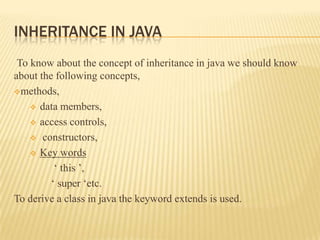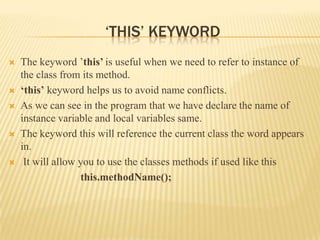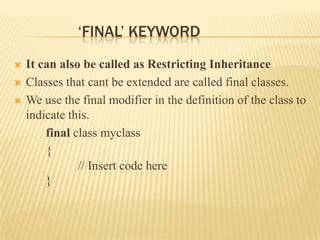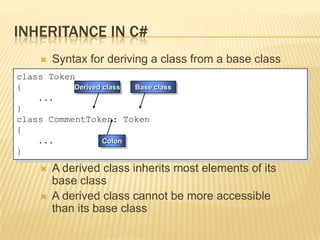Inheritance in java
- 1. IMPLEMENTATION OF INHERITANCE IN JAVA AND C#
- 2. INHERITANCE.. As the name suggests, inheritance means to take something that is already made. It is one of the most important feature of Object Oriented Programming. It is the concept that is used for reusability purpose. Inheritance is the mechanism through which we can derived classes from other classes. The derived class is called as child class or the subclass or we can say the extended class and the class from which we are deriving the subclass is called the base class or the parent class.
- 3. TYPES OF INHERITANCE The following kinds of inheritance are there in java. Simple Inheritance Multilevel Inheritance Hierarchical inheritance Use case of Interfaces (Multiple,Hybrid Inheritance)
- 4. INHERITANCE Simple Inheritance When a subclass is derived simply from it's parent class then this mechanism is known as simple inheritance. Multilevel Inheritance The process of a subclass is derived from a derived class. In multilevel, one-to-one ladder increases. Multiple classes are involved in inheritance, but one class extends only one. The lowermost subclass can make use of all its super classes' members.
- 5. INHERITANCE Hierarchical Inheritance In hierarchical type of inheritance, one class is extended by many subclasses. It is one-to-many relationship. Multiple Inheritance The process of more than one subclass is derived from a same base class. In multiple, many-to-one ladder increases. Multiple classes are involved in inheritance, but one class extends only one.
- 6. INHERITANCE Hybrid Inheritance Hybrid Inheritance is the combination of multiple, hierarchical inheritance.
- 7. IMPLEMENTATION OF INHERITANCE IN JAVA
- 8. INHERITANCE IN JAVA To know about the concept of inheritance in java we should know about the following concepts, methods, data members, access controls, constructors, Key words ‘ this ’, ‘ super ‘etc. To derive a class in java the keyword extends is used.
- 9. ‘SUPER’ KEYWORD . As the name suggest super is used to access the members of the super class. It is used for two purposes in java. 1. The first use of keyword super is to access the hidden data variables of the super class hidden by the sub class. e.g. Suppose class A is the super class that has two instance variables as int a and float b. class B is the subclass that also contains its own data members named a and b. Then we can access the super class (class A) variables a and b inside the subclass class B just by calling the following command. super.member;
- 10. CONT.. 2.Use of super to call super class constructor: The second use of the keyword super in java is to call super class constructor in the subclass. This functionality can be achieved just by using the following command. super(param-list); Here parameter list is the list of the parameter requires by the constructor in the super class. super must be the first statement executed inside a super class constructor. If we want to call the default constructor then we pass the empty parameter list.
- 11. ‘THIS’ KEYWORD The keyword ’this’ is useful when we need to refer to instance of the class from its method. ‘this’ keyword helps us to avoid name conflicts. As we can see in the program that we have declare the name of instance variable and local variables same. The keyword this will reference the current class the word appears in. It will allow you to use the classes methods if used like this this.methodName();
- 12. ACCESS SPECIFIERS IN JAVA There are four Access Specifiers in Java 1. Public: When a member of a class is declared as public specifier, it can be accessed from any code. 2. Protected: Protected is only applicable in case of Inheritance. When a member of a class is declared as protected, it can only be accessed by the members of its class or subclass. 3. Private: A member of a class is declared as private specifier, can only be accessed by the member of its class. 4. Default: When you don't specify a access specifier to a member, Java automatically specifies a default. And the members modified by default can only be accessed by any other code in the package, but can't be accessed outside of a package.
- 13. AN EXAMPLE OF MULTI LEVEL INHERITANCE A Scenario where one class is inheriting/extending the behaviour of another class which in turn is inheriting behavior from yet another class. Ex: public class Automobile {…} Public class Car extends Automobile {…} Public class Ferrari extends Car {…} This multilevel inheritance actually has no limitations on the number of levels it can go. So as far as java goes, it is limitless. But for maintenance and ease of use sakes it is better to keep the inheritance levels to a single digit number.
- 14. EXAMPLE: class Aves { Aves public void nature() { System.out.println(”Aves fly"); } } Bird class Bird extends Aves { Parrot public void eat(){ System.out.println("Eats to live"); } } class Parrot extends Bird { public void food() { System.out.println("Parrot eats seeds andfruits"); }
- 15. CONT.. public static void main(String args[]) { Parrot p1 = new Parrot(); p1.food(); // calling its own p1.eat(); // calling super class Bird method p1.nature(); // calling super class Aves method } }
- 16. HOW TO DO MULTIPLE INHERITANCE IN JAVA? Actually, java does not support multiple inheritance However, you can achieve partial multiple inheritance with the help of interfaces. Ex: public class FerrariF12011 extends Ferrari implements Car, Automobile {…} And this is under the assumption that Car and Automobile are interfaces.
- 17. INTERFACES IN JAVA An interface is a container of abstract methods. It allows Java to implement Multiple Inheritance, because a class can't have more than one superclass in Java, but can implements many interfaces. Methods are just declared in interface, but not defined. The class which implements an interface must have to define the method declared in the interface. Access modifiers and return type must be same as declared in the interface. Private and static methods can't be declared in the interface.
- 18. WHY DOESN'T JAVA ALLOW MULTIPLE INHERITANCE? Let us say the Automobile Class has a drive() method and the Car class has a drive() method and the Ferrari class has a drive() method too. Let us say we create a new class FerrariF12011 that looks like below: Public class FerrariF12011 extends Ferrari, Car, Automobile {…} And at some point of time we need to call the drive() method, what would happen? Our JVM wouldn't know which method to invoke and we may have to instantiate one of the classes that you already inherit in order to call its appropriate method. To avoid this why the creators of java did not include this direct multiple inheritance feature.
- 19. EXAMPLE interface Suzuki { Suzuki Ford public abstract void body(); } interface Ford { MotorCar public abstract void engine(); } public class MotorCar implements Suzuki, Ford { public void body() { System.out.println("Fit Suzuki body"); }
- 20. CONT.. public void engine() { System.out.println("Fit Ford engine"); } public static void main(String args[]) { MotorCar mc1 = new MotorCar(); mc1.body(); mc1.engine(); }}
- 21. How it works??? In the above code there are two interfaces – Suzuki and Ford. Both are implemented by MotorCar because it would like to have the features of both interfaces Just to inform there are multiple interfaces and not classes, tell the compiler by replacing "extends" with "implements”. MotorCar, after implementing both the interfaces, overrides the abstract methods of the both – body() and engine(); else program does not compile.
- 22. ‘FINAL’ KEYWORD It can also be called as Restricting Inheritance Classes that cant be extended are called final classes. We use the final modifier in the definition of the class to indicate this. final class myclass { // Insert code here }
- 23. IMPLEMENTATION OF INHERITANCE IN C#
- 24. INHERITANCE IN C# Syntax for deriving a class from a base class class Token { Derived class Base class ... } class CommentToken: Token { ... Colon } A derived class inherits most elements of its base class A derived class cannot be more accessible than its base class
- 25. CALLING BASE CLASS CONSTRUCTORS Constructor declarations must use the base keyword class Token { protected Token(string name) { ... } ... } class CommentToken: Token { public CommentToken(string name) : base(name) { } A private base class constructor cannot be accessed by a ...derived class } Use the base keyword to qualify identifier scope
- 26. DEFINING VIRTUAL METHODS Syntax: Declare as virtual class Token { ... public int LineNumber( ) { ... } public virtual string Name( ) { ... } } Virtual methods are polymorphic
- 27. OVERRIDING METHODS Syntax: Use the override keyword class Token { ... public virtual string Name( ) { ... } } class CommentToken: Token { ... public override string Name( ) { ... } }
- 28. WORKING WITH OVERRIDE METHODS You can only override identical inherited virtual methods class Token { ... public int LineNumber( ) { ... } public virtual string Name( ) { ... } } class CommentToken: Token { ... public override int LineNumber( ) { ... } } public override string Name( ) { ... } You must match an override method with its associated virtual method You can override an override method You cannot explicitly declare an override method as virtual You cannot declare an override method as static or private
- 29. USING NEW TO HIDE METHODS Syntax: Use the new keyword to hide a method class Token { ... public int LineNumber( ) { ... } } class CommentToken: Token { ... new public int LineNumber( ) { ... } }
- 30. WORKING WITH THE NEW KEYWORD Hide both virtual and non-virtual methods class Token { ... public int LineNumber( ) { ... } public virtual string Name( ) { ... } } class CommentToken: Token { ... new public int LineNumber( ) { ... } public override string Name( ) { ... } } Resolve name clashes in code Hide methods that have identical signatures
- 31. MULTI LEVEL INHERITANCE Multi Level Inheritance is supported in C#. Any level of inheritance is possible to inherit a class “:” is used after the class name. Like „super‟ keyword in Java, here we have „base‟ keyword which can be used during header initialization. It will invoke the immediate base class of the calling class.
- 32. SAMPLE PROGRAM class person { string name; Person int age; public person() { Console.Write("Enter Name : "); Employee name = Console.ReadLine(); Console.Write("Enter age : "); age = Convert.ToInt32(Console.Read()); Program } public virtual void put_data() { Console.Write("Name : " + name); Console.Write("Age : " + age); } }
- 33. CONT.. class employee : person { int salary; public employee() { Console.Write("Enter Salary : "); salary = Convert.ToInt32(Console.Read); } public override void put_data() { Console.Write("Salary : " + salary); } }
- 34. CONT.. class Program : employee { static void Main(string[] args) { employee e1 = new employee(); e1.put_data(); Console.WriteLine("Press any key to exit..."); Console.ReadLine(); } }
- 35. MULTIPLE INHERITANCE Like Java C# does‟nt have multiple inheritance. The reason is same that of java. We can perform that through interfaces we can implement any number of interfaces.
- 36. DECLARING INTERFACES Interface names should begin with a capital “I” interface IToken IToken { « interface » int LineNumber( ); string Name( ); LineNumber( ) } Name( ) No access specifiers No method bodies
- 37. IMPLEMENTING MULTIPLE INTERFACES A class can implement zero or more interfaces interface IToken { string Name( ); IToken IVisitable } « interface » « interface » interface IVisitable { void Accept(IVisitor v); } class Token: IToken, IVisitable { ... Token } An interface can extend zero or more interfaces A class can be more accessible than its base interfaces An interface cannot be more accessible than its base interfaces A class must implement all inherited interface methods
- 38. IMPLEMENTING INTERFACE METHODS The implementing method must be the same as the interface method The implementing method can be virtual or non- virtual Same access class Token: IToken, IVisitable Same return type { Same name public virtual string Name( ) Same parameters { ... } public void Accept(IVisitor v) { ... } }
- 39. THANK YOU














![CONT..
public static void main(String args[])
{
Parrot p1 = new Parrot();
p1.food(); // calling its own
p1.eat(); // calling super class Bird
method
p1.nature(); // calling super class Aves
method
}
}](https://image.slidesharecdn.com/inheritanceinjava-120903114217-phpapp02/85/Inheritance-in-java-15-320.jpg)




![CONT..
public void engine()
{
System.out.println("Fit Ford engine");
}
public static void main(String args[]) {
MotorCar mc1 = new MotorCar();
mc1.body();
mc1.engine();
}}](https://image.slidesharecdn.com/inheritanceinjava-120903114217-phpapp02/85/Inheritance-in-java-20-320.jpg)













![CONT..
class Program : employee
{
static void Main(string[] args)
{
employee e1 = new employee();
e1.put_data();
Console.WriteLine("Press any key to exit...");
Console.ReadLine();
}
}](https://image.slidesharecdn.com/inheritanceinjava-120903114217-phpapp02/85/Inheritance-in-java-34-320.jpg)




